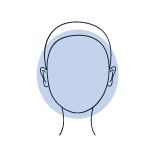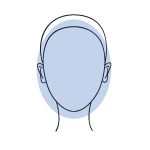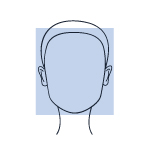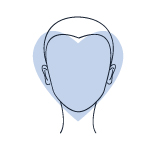Style Tips
Spectacles are a frame for the eyes. There is a wide range of frames on offer thanks to the constant search for aesthetics, technology and comfort, which allows us to produce frames in different materials and shapes. The frame is selected with the advice of our image consultants on the basis of certain characteristics:
- the shape of the face
- the type of material
- the use of the spectacles
The frame must however fit harmoniously on the face; for each face there are frames that best match the morphology of the face. It is therefore necessary to first identify the shape of the face. We can trace the possible morphologies of the face to one of two basic shapes
The shape and colours of the frame play an important role in accentuating or balancing these effects.
Try yourself via the web-cam to locate the shape of your face and notice these aspects via a virtual mirror, every person is different and the ultimate goal is to feel good about yourself.

ROUND FACE
How to recognise it?
Full round face
What frame shapes are recommended?
Oval, square frames with rounded corners

ELONGATED OVAL FACE
How to recognise it?
The distance between cheekbones is less than that of the hairline to the chin.
What forms of mottling are recommended?
Large square or round frames

SQUARED FACE
How to recognise it?
The distance between cheekbones is less than that of the hairline to the chin.
What forms of mottling are recommended?
Large square or round frames

FACE TO HEART
How to recognise it?
Ponuncated cheekbones and spacious phrases
What forms of mottling are recommended?
Teardrop, cat-eye or square frames
COLOURS THAT ENHANCE SKIN AND COMPLEXION
The tone of the complexion depends on the percentages of:
- carotene: yellow/orange pigmentation
- melanin: brown pigmentation
- haemoglobin: red pigmentation
Enhancing colours, which are in line with our natural hues, reflect and radiate outwards, making us look more beautiful and radiant. Conversely, non-enhancing colours are absorbed by the face and accentuate its irregularities.
Colours have a 'temperature' and are divided into:
- WARM: red, yellow, orange (they are associated with sunlight and its warmth)
- COLD: blue, ice, indigo (they evoke snow, the sea, the sky)
Warm colours are defined as colours that contain a percentage of YELLOW in their chromatic composition. Colours that tend towards BLUE are considered COLD.


























